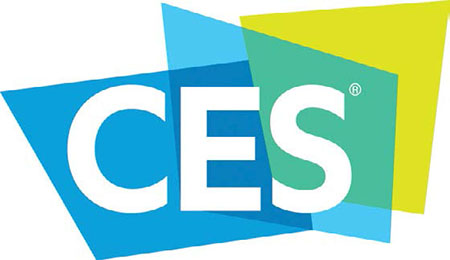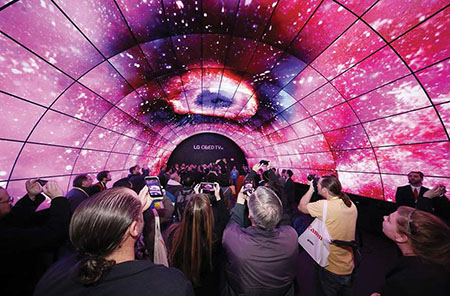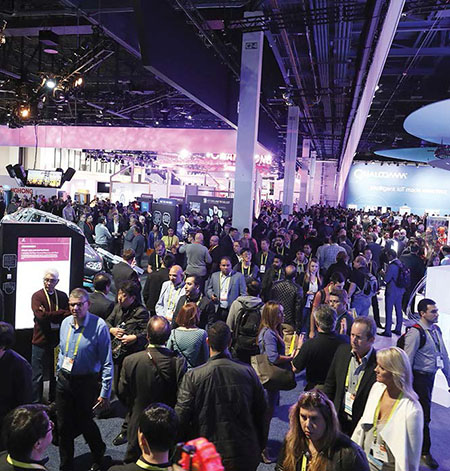CES: Next Gen TV Will Be ‘Talked About’
LAS VEGAS—ATSC 3.0 preparations and promises will permeate January’s International CES even though the technology itself will not be very visible in the sprawling exhibit halls.

With all five FCC commissioners on hand during the Jan. 9–12 event—including an on-stage chat with FCC Chairman Ajit Pai—plus the presence of all the major Next Gen TV proponents, ATSC 3.0 will certainly be a prevailing topic. Member broadcasters from the Pearl TV coalition, Advanced Television Standards Committee and large broadcasters, such as Sinclair, will be involved in multitudinous meetings about how to implement the ATSC 3.0 structure that the FCC outlined just seven weeks before CES opened.
And although Google and Amazon are not particularly identified with ATSC 3.0, their debuts as CES exhibitors are anticipated if for no other reason than the giant role they play in the multiplatform digital ecosystem. CES is loaded with content and technology crossover—and the Silicon Valley role is viewed with awe and dread, in some circles.
As for ATSC 3.0: “2018 will be a year of implementation for broadcasters and for consumer electronics manufacturers, so we expect there to be a lot of behind-the-scenes business discussions,” said Anne Schelle, managing director of Pearl TV, a coalition of broadcast groups targeting Next Gen TV. “CES will be an important meeting spot.”

Ultra high definition 4K displays, high dynamic range and advanced organic light-emitting diode (OLED) technologies will be the mainstays at many booths.
Citing the recently unveiled Phoenix Model Market project, a field trial involving multiple broadcasters and suppliers in Arizona, Schelle told TV Technology that “Pearl will be meeting [during CES]with many potential ecosystem vendors for the development of system infrastructure and consumer devices. What we learn in Phoenix will be critical for a successful deployment of Next Gen TV across the country.”
ATSC President Mark Richer agreed that broadcasters will be on the prowl at the show, an electronics extravaganza that originally focused on reception equipment but now extends into programming and many other resources for various video platforms.
“With the recent FCC action, there will certainly be a lot of conversations about the deployment of ATSC 3.0,” Richer said. “In addition, many of us will be looking at general consumer technology trends and how they might intersect with ATSC 3.0.”
Video product exhibitors such as Samsung, LG and Sony are keeping quiet about their devices until just before CES opens, although sources told TV Technology not to expect prototype 3.0 devices in their booths. With the growing presence of automotive electronics companies at the event, the electronics-makers are expected to privately show their visions for ways that ATSC 3.0 can be used to supply mobile telematics and entertainment directly to moving vehicles.
A Samsung spokesman said he couldn’t reveal Samsung’s CES plans before the show opens, but he did “applaud the FCC for adopting the next-generation broadcast TV standard.” He said the “modernized” standard will enable “robust reception, interactivity and many other features,” and he emphasized that, “Samsung engineers played a leading role in the development of the standard, and we are well-positioned to implement it in cutting-edge consumer devices as the market develops.”
TECHNOLOGY INTEGRATION
Karen Chupka, senior vice president, CES & Corporate Business Strategy at the Consumer Technology Association which produces CES, told TV Technology that television “continues to evolve,” with sets that are not just “bigger, better and smarter,” but “can do something beyond being hooked up to a linear video feed.” The evolution will be highlighted during the keynote panel “Reimagining Television” on Wednesday, Jan. 10. Hulu CEO Randy Freer and Turner Chairman/CEO John Martin will open the session.
“Having Hulu and Turner open the program demonstrates how TV has changed,” Chupka said. Freer and Martin will discuss a surprising “switch of sides” where technology companies are moving into content creation, while content companies are expanding their technology capabilities.
“Hulu and Turner are leading the way by developing strategic mehods to engage consumers, advertisers and content creators,” Chupka said.
Video and its many variations are spread throughout the sprawling CES show floor and conference sessions. Ultra high definition 4K displays, high dynamic range and advanced organic light emitting diode (OLED) technologies will be the mainstays at many booths, although LG, Samsung, Sony and the growing array of Chinese set-makers such as Hisense and TCL declined to reveal their product line-up. Nevertheless, the TV display presence at CES will be noticeably smaller in 2018, as brands such as Sharp and Toshiba have been acquired by Chinese manufacturers (often amidst much legal wrangling) and Panasonic has reduced its consumer market activities.
Getting Ready For the Crowds
“More than 170,000 people” is Karen Chupka’s official forecast for attendance at the 2018 International CES, although she hints that it won’t be a surprise if the final number approximates the crowd of 184,000 people at the 2017 show. The senior vice president, CES & Corporate Business Strategy for the Consumer Technology Association points out that all four days of the 2018 event will be on weekdays (Tuesday through Friday) rather than the traditional overlap with Saturday or Sunday. Hence, she says “people won’t be squeezing everything into two days,” which may spread out the throngs.

CTA predicts that more than 170,000 will attend the 2018 International CES.
Also spread out is the CES land mass: about 2.6 million square feet of exhibit space, about equal to 2017, with about the same number—4,000—exhibitors showing their wares.
CES is also reminding attendees of the increased safety and security measures, including photo IDs on all attendee and media badges, prohibition of rolling bags on the show floor and other restrictions “in line with guidance from federal law enforcement and industry best practices,” according to CTA.
Gary Arlen
CTA’s own forecasts suggest that UHD and HDR offer the best promise for sales of large screen TV sets. In its latest wholesale prediction, CTA said it expects 10.6 million “HDR-compatible” sets to go through the distribution pipeline this year (26 percent of total TV volume). It also foresees that the boost in 4K/HDR volume supports faster growth in big screen TVs (bigger than 40 inches).
“Accompanying the better-than-expected volumes are, naturally, lower-than-expected prices—but the [pricing] devil is in the details,” according to the CTA analysis.
The CES exhibit floor includes a new “Sport Zone” plus marketplaces (clusters of mosly small booths) on topics such as drones, artificial intelligence, robotics and smart cities. A new “Design and Source” marketplace will showcase companies that are “part designers and part original equipment manufacturers,” Chupka said.
Amazon will show its wares in large conference rooms at the Venetian, while Google has constructed a large temporary structure in the Central Plaza in front of the Las Vegas Contention Center. Neither company has yet disclosed what it will highlight in its exhibit areas, although their content services as well as their respcetive hardware (smartphones, e-readers and home assistants) are likely to be centerpieces of their displays.
TALKING SHOP
Pai’s sit-down conversation with CTA President/CEO Gary Shapiro on Wednesday at 11:30 a.m. is expected to cover net neutrality, Next Gen TV, connectivity, spectrum issues and other developments in broadband and competition policy that have rocked the Chairman’s first year at the helm. Immediately afterwards, Federal Trade Commission Acting Chairwoman Maureen Ohlhausen will sit down with Shapiro to discuss her agency’s role in privacy, the Internet of Things, disruptive innovation and other technological developments on the FTC agenda.
On CES’s opening afternoon (Tuesday at 3:30 p.m.), four FCC commissioners will offer a 2018 Preview roundtable. Commissioners Brendan Carr, Mignon Clyburn, Michael O’Reilly and Jessica Rosenworcel will join CTA Vice President for Regulatory Affairs Julie Kearney to examine 5G, broadband deployment, accessibility and other topics.
For more information, visit cesweb.org.
For a comprehensive list of TV Technology’s ATSC 3.0 coverage, see our ATSC3 silo.
Get the TV Tech Newsletter
The professional video industry's #1 source for news, trends and product and tech information. Sign up below.
Gary Arlen, a contributor to Broadcasting & Cable, NextTV and TV Tech, is known for his visionary insights into the convergence of media + telecom + content + technology. His perspectives on public/tech policy, marketing and audience measurement have added to the value of his research and analyses of emerging interactive and broadband services. Gary was founder/editor/publisher of Interactivity Report, TeleServices Report and other influential newsletters; he was the long-time “curmudgeon” columnist for Multichannel News as well as a regular contributor to AdMap, Washington Technology and Telecommunications Reports; Gary writes regularly about trends and media/marketing for the Consumer Technology Association's i3 magazine plus several blogs.

